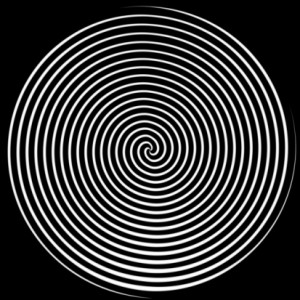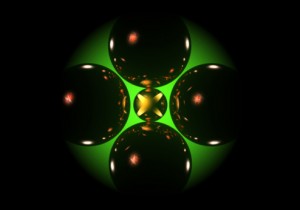The Kabbalistic Multiverse
By Nir Menussi: March 25, 2011: Category Inspirations, Networks of Meaning
Integrating Science and Mysticism, Article 12
 We are now ready to approach the process of integration itself. What we’re going to attempt in the following few articles is to present an actual, specific Kabbalistic model, and then demonstrate how that model enables us to combine scientific knowledge with Torah beliefs and concepts. The model we’re going to examine is called the “four worlds” model, and we’ll begin with an overview.
We are now ready to approach the process of integration itself. What we’re going to attempt in the following few articles is to present an actual, specific Kabbalistic model, and then demonstrate how that model enables us to combine scientific knowledge with Torah beliefs and concepts. The model we’re going to examine is called the “four worlds” model, and we’ll begin with an overview.
The Four World(view)s
Kabbalah speaks of our physical world as the lowest ‘rung’ in a ladder of many non-physical worlds, ascending higher and higher towards God. What we refer to as the ‘creation of the world’, was in fact, according to Kabbalah, a progressive uncoiling or revealing of these many worlds, ending with the physical universe. Likewise, spiritual elevation, such as the one meant to be experienced in prayer, is likened to climbing up this ladder of worlds.
Although these worlds are deemed to be infinite in number (they have to be, since an infinite ‘distance’ separates physical creation from its Creator, so to speak), they are generally divided into four main worlds, or sets of worlds. Counting from the top down, these four general worlds are called the World of Emanation (Atzilut in Hebrew), the World of Creation (Beriah), the World of Formation (Yetzira) and the World of Action (Asiya).
The meaning of these particular terms will be discussed shortly. Meanwhile, it’s revealing to take a look at the verse from which the last three of these terms were taken, from the prophet Isaiah (43:7):
“All that is called in My name and for My honor, I have created it, I have formed it, I have even made [=acted] it”
As is clear from the verse, the three verbs to create, to form and to make/act, all refer to one and the same object. What this seems to imply is that there are not many worlds but one, and that this one world was at once created, formed and made (and applying the fourth Kabbalistic term, added later as referring to the what “is called in My name and for My honor” itself, also emanated). In other words, we need not necessarily think of the Worlds model as saying that there are four separate worlds or universes, but rather that there is one world, with four separate ways of thinking about how it becomes. In other words, the four ‘worlds’ are really four world-views, lenses through which the world appears in four different forms.
The totality of these four world-images, all reflecting the one imperceptible world, we will call The Kabbalistic Multiverse. The term ‘multiverse’ has recently been used to refer to the notion that reality is made up of many universes, ours being just one of them. As we said, this is quite similar to the classical Kabbalistic notion of many worlds. Here, however, we wish to use the term to refer to the more subtle concept that there is one universe which can be perceived in many ways. These perceptions are so different that they seem to be pointing at several universes, but they are really all glimpses of the one multiverse.
As you can probably guess, the Kabbalistic Multiverse is fundamental to integrating the two conflicting worldviews that are Torah and science.
An Old-New Glossary
We shall now briefly go over the names of the four worlds and explain how each one of them describes the world as coming into being.
Emanation is when something extends away from its source without ever detaching from it. Since the thing being emanated never leaves its source of emanation, the two are actually always one and the same. The concept of the world being emanated is therefore a highly mystical one, which says that the world is part and parcel of Divinity, an extension of God which is ultimately indistinguishable from Him.
Creation is the coming into being ex nihilo—something from nothing. Unlike an emanation, a creation is separate from its creator. However, a creation must be in constant contact with its creator, since its very being is derived from it. If the creator were to let it go for even an instant, it would cease to exist. The idea of the world being created says that the world is constantly and intentionally being brought into existence by a higher, invisible entity. While this entity belongs to a higher level of reality than ours, since we have no direct perception of it we see it as ‘nothing’, therefore describing the creation of the world as ‘something from nothing’.
Formation is the much more familiar process of something which already exists assuming a new shape. Unlike an ex nihilo creation which can never leave the hands of its creator, a form is independent from its designer and carries on without him. The idea that the world is formed means that, its existence being a given, it shifts and changes—or more simply, trans-forms—from one essential state to another. However, for the world of Formation which is a relatively high and spiritual one, the characteristics of these states are considered very real and distinct, much like the Platonic ‘ideas’ (or ‘forms’ as they’re called in some English translations).
Action (or making as above) is the most familiar and observed process of all: gradual, minute change. When something is said to be ‘acted upon’ or ‘made’ it means that small modifications occur to it, changing it ever so slightly. This is similar to Formation in the sense that the existence of the object is a given and we are describing qualitative changes happening to it; however, because changes of action are so gradual, one cannot at any step of the way say that the thing acted upon has just assumed a completely new form. Its essence remains continuously the same. The view of the world being acted / made means that it changes and develops according to gradual and continuous processes of cause and effect.
The Hiding of the Face of God
 As we can see, while we are climbing down the ladder of worldviews, God’s face becomes increasingly hidden, while reality becomes more and more independent and concrete. According to the world-view of Emanation the world is one with God; according to Creation it is constantly and directly given existence by God; according to Formation it’s designed by God from afar; and according to Action it grows of its own, seemingly needless of God.
As we can see, while we are climbing down the ladder of worldviews, God’s face becomes increasingly hidden, while reality becomes more and more independent and concrete. According to the world-view of Emanation the world is one with God; according to Creation it is constantly and directly given existence by God; according to Formation it’s designed by God from afar; and according to Action it grows of its own, seemingly needless of God.
It is clear that the world-view most analogous to science is that of Action. This affinity and more will be discussed in the next article.
http://www.interinclusion.org/inspirations/from-cosmos-to-creation-article-13/
The Kabbalistic Multiverse,























;)
;)
;)
;)
;)
;)
;)
;)
;)
;)
